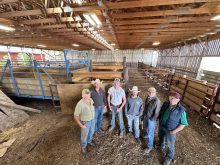No doubt — the livestock industry is changing and livestock transporters have no intention of getting left behind. As of November, 2008, more than 230 people had completed training and received certification under Alberta Farm Animal Care’s (AFAC) Certified Livestock Transport (CLT) program.
Certification is proof that drivers know how to handle animals, says Mikki Shatosky, CLT project co-ordinator. It’s voluntary training that adds to their list of credentials. Many commercial transport companies now have qualified in-house instructors to train and certify their employees. So far, there is one independent instructor in each of Alberta, Saskatchewan and Ontario to deliver CLT wherever it is requested.
Read Also

Alberta ranch family outlasts droughts
Over the years, the Lehr family has learned a thing or two about managing the ranch through dry years
“The demand is really kicking in now,” Shatosky adds. “When it started, we thought it would be just for Alberta, but the demand is coming from across Canada.” It stands to reason that demand follows livestock wherever they are transported, and millions cross the highways and byways of Canada’s provinces and the United States every year.
In fact, this year’s livestock transportation conference, set for January 29 in Calgary, reflects the North American and global reality of the livestock transportation industry. It will take a big-view look at global initiatives, training, audit systems, science and regulations. The aim is to address the well being of animals, raise the profile of the livestock transportation sector in the value chain, provide education and explore cross-border collaboration. It’s for truckers, producers, processors, transport and food companies, enforcement and government personnel.
The CTL course itself is geared toward tuckers, producers and people who work in shipping and receiving departments of facilities that handle live animals. Basic topics include livestock transport regulations in Canada and the U. S., animal behaviour, livestock handling and care during loading, transit and unloading, driving with live cargo (weather, road conditions, logistics), risk factors (emergency situations, border closures), and the impact of transportation on meat quality. Shatosky says the manual is a living document that will change over time as new regulations and standards are introduced and research leads to innovations in transportation and animal care.
Though AFAC spearheaded the course, the content was developed by an industry advisory group under the experienced hand of livestock and transportation consultant Tim O’Byrne. After 19 months in the making, it was launched with a pilot train-the-trainer course in May of 2007 and a second early in 2008.
Quality beef on board
Brian Heitman, trucking manager and in-house CLT trainer for Cor Van Raay Farms, was among those who took the first training course. What caught his attention was the certification tied to the CLT program. “There are other courses out there,” he says, “but with this one there is a record to trace back to know if drivers have participated in the program, and whether they are certified for beef, pork, or poultry.” The company’s eight drivers who have taken the course now have















